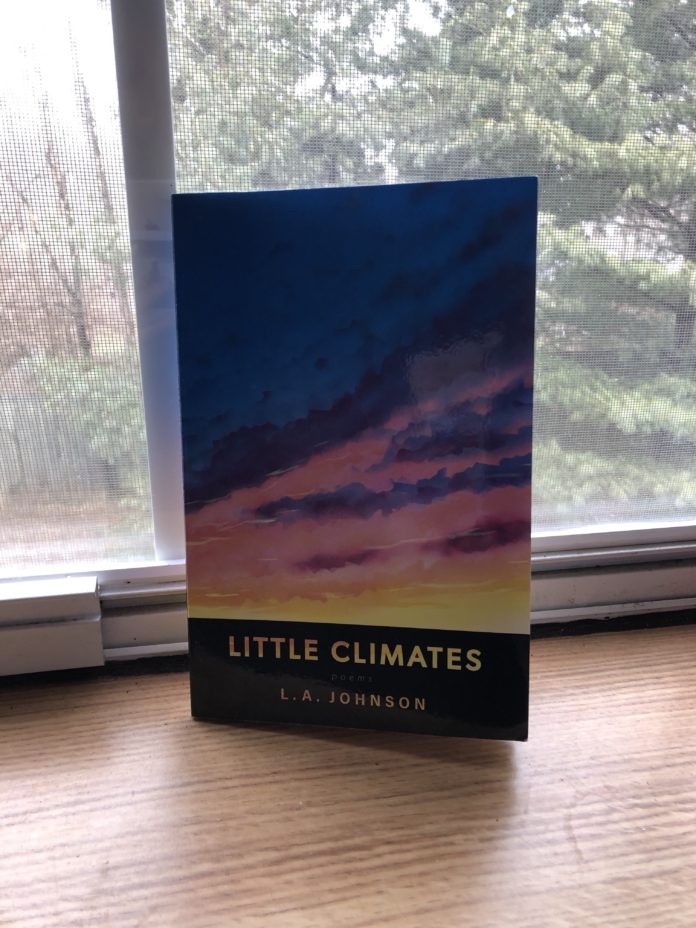Welcome to Lit Review, where columnist Dominiq Wilson will take apart a series of chapbooks to figure out what works and what doesn’t for the modern reader of poetry.
Little Climates is a debut collection of twenty-three poems by L. A. Johnson. The title is an apt descriptor of the theme throughout the book, and although the subject of each poem varies, all of them tell the story of little climates.
Before I began to read these poems, I took the liberty of googling the definition of climate; frankly, my fifth-grade science vocabulary isn’t as fresh as I’d like it to be. I got the idea that it describes the general weather of an area over time, and while the weather is often mentioned throughout this book, I interpreted climate as the general feelings or emotions that turn the poem’s subject–small or large–into something more than the subject itself.
Take the poem “Good Behavior,” for example:
Just past the winter-quiescent fields, the house
stood, lead paint peeling, The door opened
a crack, to let the stale air in. We’d always assumed,
but we couldn’t see much through the windows.
Instead we saw her hands, forked like claws,
and molded blankets shivered-white on the lawn.
Judgement in whispers kept us comfortable.
The neon sign for the Big 6 Market blinked on and off.
On good weekends, we danced a while,
kept our thin arms spaced at a proper distance.
What could I have known then of devotion,
lives not run out but ruinous, and all at once.
I interpreted this poem to be describing the interaction with a homeless woman, but there are only about three lines that signal this meaning. The rest describes the area and the epiphany that comes after the interaction. “Split-Level,” “Self-Portrait as Norway Spruce,” “Auroras,” and “Provenance” are also great examples of the poem’s subject being smaller in comparison to the “climate” surrounding it.
The form that these poems take, like the one above, is consistent throughout the page, but I do favor the poems that are formatted in couplets—that is, stanzas with two lines each containing an end rhyme. In poems that take a sour turn, like “Oarfish” and “Impermanence,” this form works in favor of the poem by pairing the end of the good and the beginning of the bad in the same stanza. It definitely surprises you and causes you to take a second look.
The only poem that isn’t somewhat consistent throughout is “Atlas.” It’s also one of the few poems in the book that runs onto another page. The poem utilizes couplets and monostitches—a one-line stanza—and are separated every four stanzas by a decorative symbol. I have to admit that the inconsistent form surprised me and made the poem a bit more difficult to understand, but it was enjoyable nonetheless.
Lastly, there are two poems in this collection that are connected by the same title: “Shapeshift” on page seven, and “Shapeshift” on page 10. I tried to see if the poems in between this pairing were related, and to no avail, but the connecting themes between these poems are strikingly obvious.
The two “Shapeshift” poems are consistent in form, with each three-line stanza being labeled with Roman numerals, and each have a similar subject of what could be encountered when walking through the woods. The only difference I noticed was that the first “Shapeshift” took place in daylight, while the second took place at night. Both were a bit hard to navigate through but were very visual, which I appreciate. As someone who’s never really taken a walk through the woods, it’s nice to imagine what I would interact with.
Overall, I found this book to be very enjoyable, despite the heavy topics discussed. I will admit that there were more poems I couldn’t crack the code to, like “Silvering,” but in all of them, there is enough to grab onto and appreciate. For the “Silvering” poem, in particular, I learned about the varied uses of silver throughout history. The more you know!
If you’re interested in reading this book, it can be purchased online ranging from $9 to $12, and is small enough to carry with you without contributing to the weight of your backpack. I was lucky enough to borrow this book from Professor Manning.




[…] Like the last chapbook, there was a time that the poems in this book reminded me of previous poetry I’ve read this year. A poem from “Plein Jeu,” “After Our Wedding,” is arranged in couplets like many of the poems in L. A. Johnson’s Little Climates. […]